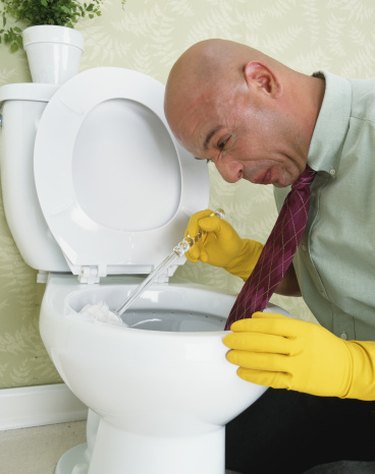
Drano, an S.C. Johnson Brands product line, includes several different types of drain cleaners and one formula designed for pipe and septic system care. Drano Pipe & Septic Care is safe for use in toilets but won't dissolve clogs. Drain cleaners come in liquid, gel, foam and crystal versions and should never be used in a toilet. Heat produced by the drain cleaner could cause several hazardous problems.
How Drano Works
Video of the Day
Drano contains sodium hydroxide or caustic lye, along with other chemicals designed to carry and distribute the lye along the inside of the drain system. Sodium hydroxide reacts violently when it contacts water and creates intense heat. The heat burns away hair and melts grease, two major causes of drain clogs. As Drano dissolves clogs in pipes, the water in the pipes boils. Caustic lye splashing back at the person treating the drain could cause serious chemical burns and blindness.
Video of the Day
Explosion Dangers
If poured into a clogged toilet, Drano could cause the toilet contents to blow out into the bathroom. The chemical reaction between sodium hydroxide in the Drano and the water in the toilet creates enough heat to melt grease clogs and burn hair. SC Johnson warns that even when using Drano on an approved problem, users should cover the drain openings and protect themselves from splashback. Any liquid boiling and splashing out of the bowl could still contain sodium hydroxide.
Toilet Seal Damage
A ring of wax seals the connection between the toilet base and the opening of the sewer system. Bolts at the base of the commode provide physical support but not a watertight seal. During installation, plumbers heat the wax seal until soft, and then press the toilet base securely onto it. Heat from the chemical reaction Drano causes might melt the wax seal and create a sewage leak at the base of the toilet.
Toilet Damage
Drano won't harm the toilet bowl by chemically reacting with the porcelain. Drano could create enough local heating to cause severe expansion damage to the bowl. When porcelain heats unevenly, hot portions of the ceramic expand, but cold portions remain unchanged. The temperature difference creates enough stress to crack the porcelain bowl. Hairline cracks could cause the toilet to fail while in use or allow the toilet bowl contents to seep slowly out onto the bathroom floor.